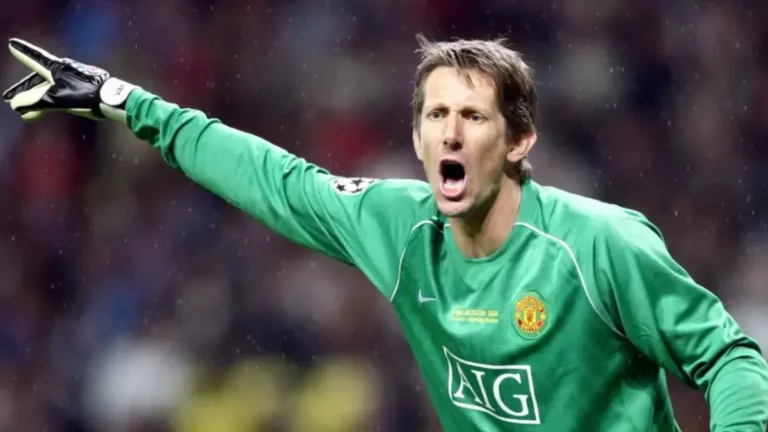Edwin van der Sar Suffered a Stroke: Are Ex-footballers More at Risk?


Reviewed and approved by the doctor Leonardo Biolatto
On Friday, July 7, the legendary Dutch goalkeeper suffered a brain hemorrhage while on vacation on a Croatian island. So far, his state of health is stable, although worrying, according to an official statement issued by the Ajax club.
Beyond the case of Edwin Van der Sar, scientific evidence indicates that soccer players are more at risk of suffering from brain diseases in the medium and long term. We’ll take a closer look at what this means in this article.
How is Edwin van der Sar’s state of health?
A few days ago, the soccer world was alarmed by the sad news: Edwin van der Sar, the historic Dutch goalkeeper, suffered a stroke. The first official announcement was made by the Amsterdam club Ajax, where the former player spent a large part of his career:
This Friday, Edwin van der Sar has had a hemorrhage around his brain. He’s currently in the hospital, in the intensive care unit, and is in stable condition. His condition is stable, but still worrisome.
Van der Sar, who until May this year was the general manager of Ajax, was on vacation with his family in Croatia. The 52-year-old former goalkeeper suffered a fall and was rushed by helicopter to a local hospital. There he was admitted to the intensive care unit (ICU), where a ruptured blood vessel in his brain was detected.
What is a stroke?
There are two types of stroke: hemorrhagic and ischemic. Both can destroy brain cells, causing severe damage to major functions and risk of death.
Ischemic stroke is caused by a blockage of a blood vessel that carries blood to the brain. Such blockage may occur due to a narrowing of the arteries or a blood clot.
On the other hand, hemorrhagic stroke occurs when a blood vessel in the brain ruptures and blood is distributed throughout the area. According to the information disclosed so far, this would be the case for Van der Sar.
Are footballers more at risk of suffering from brain diseases?
The news has raised a key question for soccer and sport in general: are professional footballers more at risk of suffering from brain diseases? Although this is a field of ongoing research, there are several studies that have already worked on the subject and have answered in the affirmative.
The risks correspond to the typical traumas of contact sports, such as head contusions. In soccer, in addition, frequent blows to the skull with the ball during headers.
Beyond the possibility of immediate serious injuries during practice, it’s also being investigated whether athletes have a higher risk of suffering from brain diseases in the long term. Furthermore, whether this risk includes neurological diseases and accelerated cognitive deterioration.
We think you may also enjoy reading this article: How Many Games do Soccer Players Play Per Year and What Are the Risks?
What does the Spanish Society of Sports Medicine say?
A report by this entity describes that the sports with the highest incidence of head injuries are soccer, cycling, rugby, horseback riding, cycling, and some aquatic sports. Although they represent a smaller percentage compared to other sports injuries, they are the ones that can lead to greater long-term complications.
On the other hand, the report indicates that concussions represent between 5% and 9% of injuries during sports practice. This can occur when the head hits a moving object and the consequences vary according to the severity of the case.
Some possible symptoms are as follows:
- imbalance
- forgetfulness
- headaches
- nausea and vomiting
- loss of consciousness
- changes in alertness
According to this work, repeated concussions and repetitive head-balling may be a risk factor for mental health and cognitive impairment. However, more studies are needed to understand how and to what degree these practices are linked to other neurological diseases.
A study of former players of the Norwegian national team
Another study, published in the specialized journal Neuroradiology, examined 33 former players of the Norwegian national soccer team using brain computed tomography. They found that one-third of these athletes had central brain atrophy.
The authors conclude that such a condition may be due to repetitive small head injuries from the sports they play.
A recent paper from the University of Glasgow provides concrete data
The University of Glasgow carried out a comparative study between 7676 former Scottish professional soccer players and 23,028 people from the general population control. The results indicated that these athletes had a higher percentage of mortality from causes related to neurodegenerative diseases.
In contrast, mortality from other common diseases was lower. In addition, the work revealed that former soccer players were more frequently prescribed dementia-related medications.
Crashes, headers in soccer, and a risk of concussions
A study published in The American Journal of Sports Medicine had as its research population soccer players who competed in the U.S. Olympic Sports Festival. The surveys revealed that there were 74 concussions in 39 male players, while there were 28 concussions in 23 female players.
The work highlights the relevance that headers have in this situation, although it does not detract from the importance of other instances of the game. It is made clear that, according to the data collected, concussions from player-to-player contact are a frequent hazard in soccer. These collisions accounted for 48 of the 74 concussions revealed.
Like this article? You may also like to read: Skilled Dutchman is Mistaken for Messi’s Son: Learn 5 Benefits of Soccer for Children
The treatment and rehabilitation that awaits Edwin van der Sar
The treatment of a stroke depends on the severity of the stroke. If the former goalkeeper suffered a hemorrhagic variant, the aim is to reduce the pressure generated in the brain.
There are different alternatives for treatment, including the following:
- Medication to dissolve blood clots, if any.
- Mechanical removers to remove clots and debris.
- Surgery to remove the blood and repair affected blood vessels.
Rehabilitation consists of recovering the abilities that may have been affected by the stroke, as well as the intake of drugs to prevent future similar situations. Another important aspect is to reduce risk factors, such as high blood pressure and high cholesterol.
Although more research is needed to determine the incidence of soccer practice on strokes, there are studies that focus on the risk of dementia and other brain diseases. According to the studies published to date, collisions between players and repetitive head-butts increase the risk of such conditions.
All cited sources were thoroughly reviewed by our team to ensure their quality, reliability, currency, and validity. The bibliography of this article was considered reliable and of academic or scientific accuracy.
- Barnes, B. C., Cooper, L., Kirkendall, D. T., McDermott, T. P., Jordan, B. D., & Garrett, W. E., Jr (1998). Concussion history in elite male and female soccer players. The American journal of sports medicine, 26(3), 433–438. Consultado el 10 de julio de 2023. https://doi.org/10.1177/03635465980260031601
- Mackay, D. F., Russell, E. R., Stewart, K., MacLean, J. A., Pell, J. P., & Stewart, W. (2019). Neurodegenerative Disease Mortality among Former Professional Soccer Players. The New England journal of medicine, 381(19), 1801–1808. Consultado el 10 de julio de 2023. https://doi.org/10.1056/NEJMoa1908483
- Moreno, A. L. (2022). Consecuencias del golpeo de balón con la cabeza en el fútbol. Monográfico sobre el traumatismo craneoencefálico y conmoción cerebral en el deporte. Arch Med Deporte 2022; 39(5): 265-268. Consultado el 10 de julio de 2023. http://archivosdemedicinadeldeporte.com/articulos/upload/Monografico_Femede_211.pdf#page=25
- Sortland, O., & Tysvaer, A. T. (1989). Brain damage in former association football players. An evaluation by cerebral computed tomography. Neuroradiology, 31(1), 44–48. Consultado el 10 de julio de 2023. https://doi.org/10.1007/BF00342029
This text is provided for informational purposes only and does not replace consultation with a professional. If in doubt, consult your specialist.








